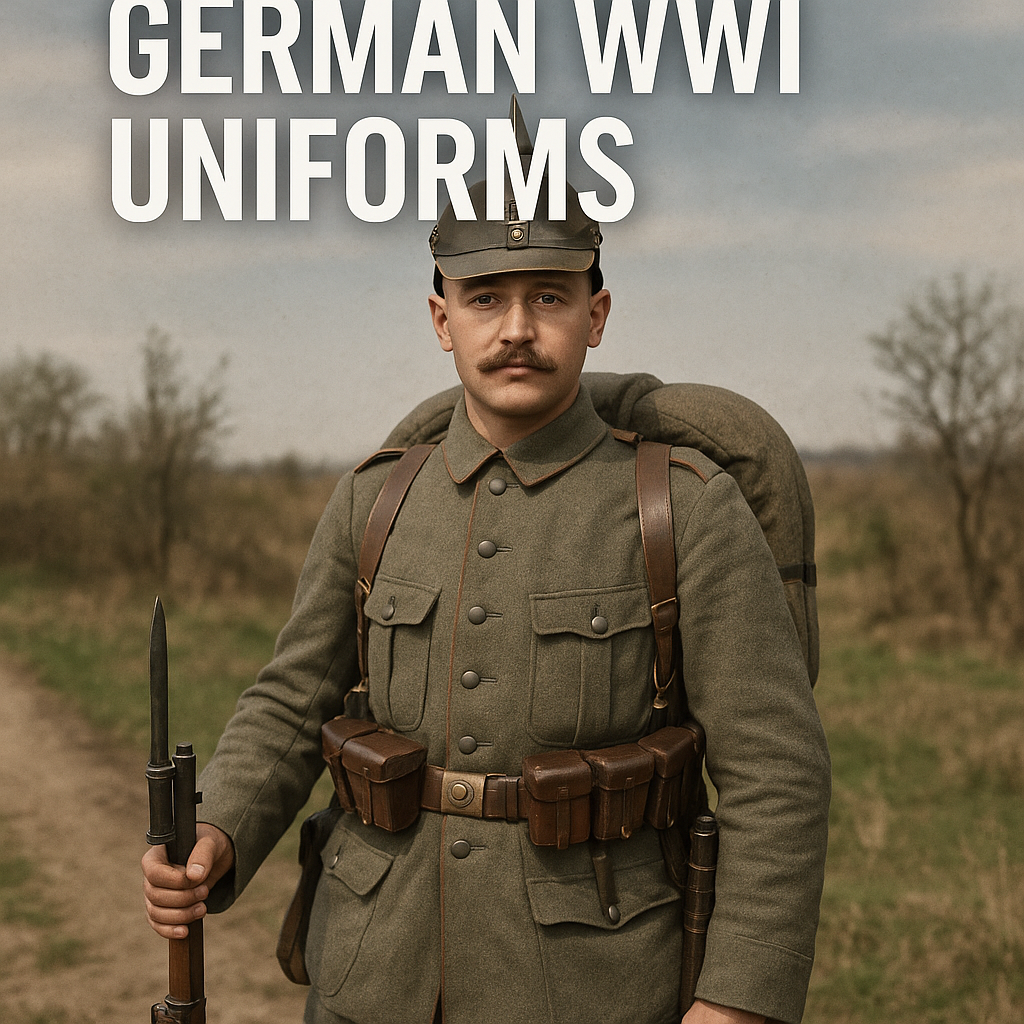
Complete Guide to German WWI Uniforms: Evolution, Gear & Historical Insight”
Published on Jun 25, 2025
Complete Guide to German WWI Uniforms: Evolution, Gear & Historical Insight
When World War I erupted in 1914, the German army entered the battlefield dressed in uniforms that reflected tradition more than practicality. Known for their iconic spiked helmets (Pickelhaube) and field-grey (feldgrau) tunics, the German WWI military uniforms soon underwent significant changes to meet the grim demands of trench warfare.
Whether you’re a collector, reenactor, or history enthusiast, understanding the German uniform WWI story gives rich insight into the culture, functionality, and resilience of the soldiers who wore them.
⚔️ The Early War Uniform: Prestige and Prussian Influence
At the start of the Great War, WWI German soldiers marched into battle wearing uniforms deeply rooted in 19th-century Prussian military style. Designed for parade-ground grandeur rather than battlefield effectiveness, the 1914 uniform emphasized appearance over utility.
Key Components of the 1914 German Uniform:
- Pickelhaube Helmet: Made of hardened Leather with a distinctive spike. It was designed initially to deflect cavalry sabers.
- Feldgrau Tunic: A grey-green wool jacket ideal for blending into the European countryside.
- Red Piping: Colored trim indicated branch or regiment.
- Leather Equipment Belts: Held ammo pouches, bayonets, and tools.
- Jackboots: High-quality knee-length boots made of Leather.
The goal was to maintain a sense of imperial pride — but trench warfare's static, muddy, and brutal conditions would soon force drastic uniform reforms.
🔄 Evolution of the Uniform (1915–1918): Function Over Form
By 1915, the realities of war were painfully apparent. The German uniform began to evolve rapidly due to:
- Increased casualties from inadequate protection
- Shortages of quality materials like Leather
- Demands for better camouflage and warmth
Significant Changes During the War:
- Stahlhelm Replaces Pickelhaube (1916)
- The M1916 Stahlhelm was a steel combat helmet offering superior protection from shrapnel and bullets. It quickly replaced the vulnerable Pickelhaube and became one of the most iconic German military symbols of the 20th century.
- Simplified Tunics
- Ornate red piping and colored cuffs were removed. The simplified M1915 tunic was more practical, easier to produce, and better suited for mass mobilization.
- Cloth-Based Equipment
- As the war stretched supply lines thin, canvas and cloth replaced Leather in belts and pouches.
- Trench Coats & Weather Gear
- Long wool coats, capes, and scarves were issued for extreme cold, particularly on the Eastern Front.
- Camouflage Use Increases
- Snipers and scouts began using camouflage smocks and helmet covers to reduce visibility in the trenches.
🛡️ WWI German Army Gear and Soldier Equipment
A German soldier’s uniform was only one part of his battlefield ensemble. Field gear and accessories completed the look — and were critical for survival.
Standard Equipment:
- Gewehr 98 Rifle: The standard-issue bolt-action rifle.
- Bayonet: Typically mounted on the rifle for close combat.
- Gas Mask (1915 onward): After the introduction of chemical warfare.
- Entrenching Tool: A small shovel used for digging foxholes and trenches.
- Bread Bag, Canteen & Mess Kit: For food and hydration.
- A-Frame Pack: Carried extra gear like socks, rations, and personal items.
As the war progressed, gear became more lightweight, adaptable, and uniform across divisions.
🧵 Rank and Regiment: How to Identify a WWI German Uniform
Many collectors and reenactors rely on insignia and regimental markings to authenticate and categorize German WWI uniforms.
How to Identify Rank & Regiment:
- Shoulder Boards: Contained regiment numbers and colors.
- Collar Tabs: Signified branch of service (infantry, artillery, etc.).
- Chest Medals: Distinguished decorated soldiers.
- Cuff Titles: Used by elite units like the Guard Regiments.
Understanding these elements helps accurately identify and date uniforms — a crucial step for historians and antique dealers.
🧰 Authentic Reproductions: For Collectors & Reenactors
Today, the demand for WWI German uniform reproductions is higher than ever. Enthusiasts seek historical accuracy for:
- Reenactments
- Museum displays
- Historical films
- Private collections
Paddelaters.com offers high-quality reproductions, complete with correct stitching, period-accurate materials, and authentic gear layouts — helping preserve the memory of this vital era.
🔄 WWI vs. WWII German Uniforms: What’s the Difference?
Though similar at a glance, WWI and WWII German uniforms have key differences:
FeatureWWIWWII
Helmet Pickelhaube → Stahlhelm Stahlhelm (advanced models)
Tunic Design Ornate → Simplified More standardized, utilitarian
Color Feldgrau (green-grey) Variants of feldgrau + camo
Equipment Leather → Cloth gear More metal, synthetic gear
Symbolism Imperial insignia Nazi symbols (1935–45)
Collectors should pay close attention to insignia, helmet shape, and material to distinguish between eras.
📌 Why German WWI Uniforms Still Fascinate Today
From Hollywood films to reenactment events, WWI German uniforms continue to captivate audiences for their unique blend of tradition, symbolism, and wartime innovation. They represent a transitional moment in military history — when armies moved from old-world style to modern battlefield function.
🧾 Conclusion
The story of the German WWI uniform is one of transformation. Beginning as a proud symbol of Imperial elegance, it evolved into a practical outfit built for survival in the trenches. With iconic elements like the Pickelhaube, the sturdy feldgrau tunic, and the later Stahlhelm, these uniforms are a visual record of the changing face of warfare.
Whether you’re researching, collecting, or fascinated by military history, exploring the detail and depth of these uniforms offers insight into one of the world’s most defining conflicts.
